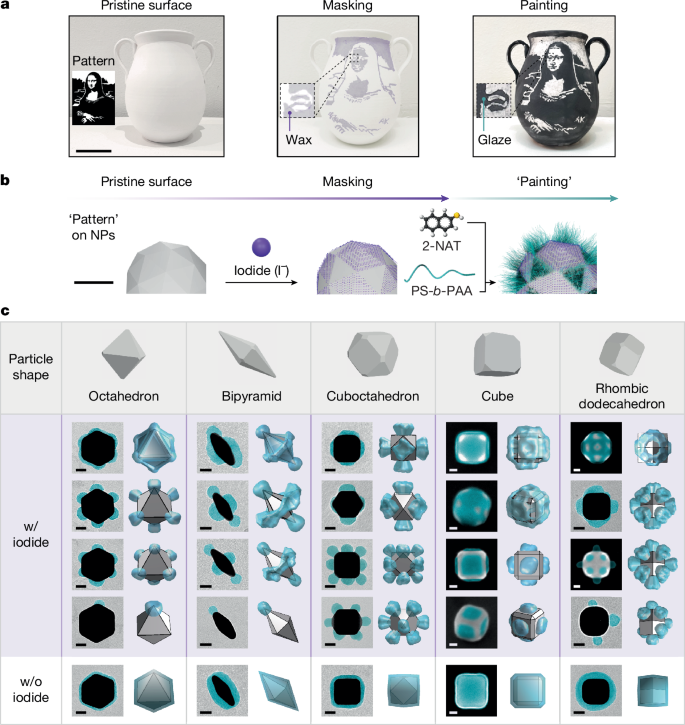Patchy nanoparticles by atomic stencilling
Summary
This paper demonstrates a bottom-up “atomic stencilling” method that patterns ligands on faceted gold nanoparticles (NPs) with nanometre precision. The approach uses iodide adsorption as an atomic-scale mask and 2-naphthalenethiol (2-NAT) plus block-copolymer grafting (PS-b-PAA) as the “paint” to create polymer patches only on selected facets or vertices. The authors synthesised a library of over 20 distinct patchy NP types across five shapes (octahedron, bipyramid, cuboctahedron, cube and rhombic dodecahedron), with high yields (17 types >80%).
Density functional theory (DFT) shows facet-dependent iodide binding (Au(111) masked first), explaining selective masking. A multiscale modelling workflow — linking DFT, polymer scaling theory, MD grafting simulations and Monte Carlo assembly simulations — predicts patch patterns and sizes and matches experiments. Patchy NPs self-assemble into large, open superlattices (BCC and BCT) with unusually large interparticle spacing, driven by directional interactions from the patches. The method is scalable and transferable to other metals and polymers, with potential applications in metamaterials, catalysis, quantum devices and precision nanoparticle engineering.
Key Points
- Atomic stencilling: iodide acts as a stable, facet-selective mask on gold NPs; 2-NAT and polymer grafting create patches only on unmasked regions.
- Library produced: more than 20 patchy NP types across five shapes; 17 types achieved yields above 80%.
- Facet dependence explained by DFT: Au(111) is preferentially masked by iodide, enabling controlled face- vs vertex-patching by tuning [I−] and [2-NAT].
- Multiscale theory and simulation (DFT → adsorption model → polymer scaling → MD/MC) predict patch sizes, transitions and assembly behaviour, agreeing with experiments.
- Self-assembly: patchy NPs form large-scale, open superlattices (BCC/BCT) with low packing fractions and tunable interparticle spacing governed by patch geometry and interactions.
- Generalisable and scalable: approach works for other thiols, block copolymers and at least one other metal (Pd); potential for wide applications in materials and nanotechnology.
Context and relevance
Top-down lithographic patterning is powerful but limited for curved or complex nanoscale objects. This work brings the stencil concept to the atomic scale by leveraging facet-selective adatom adsorption and polymer physics, achieving reproducible, high-yield patterning on 3D nanoparticle surfaces under solution conditions. That unlocks controlled directional interactions (colloidal valency) for sub-100 nm particles, enabling assembly of open lattices and offering a route to design functional nanoparticle-based materials with emergent mechanical, optical and catalytic properties.
Author style
Punchy: this is a significant step for nanoscale surface engineering. The combination of clear mechanistic insight (DFT), practical chemistry (iodide masking + polymer grafting) and predictive multiscale models makes the work both robust and broadly useful. If you care about controlled nanoparticle interactions or building new metamaterials from the bottom up, read the full methods and phase diagrams — they actually tell you how to reproduce and tune the outcomes.
Why should I read this
Short answer: because they solved a practical way to “paint” nanoparticles with nanometre control and high yield, then showed those painted particles build entirely new, open crystal lattices. If you work on nanoparticle self-assembly, functional coatings, catalysis or nanophotonics, this saves you months of trial-and-error — they give the how and the why.

